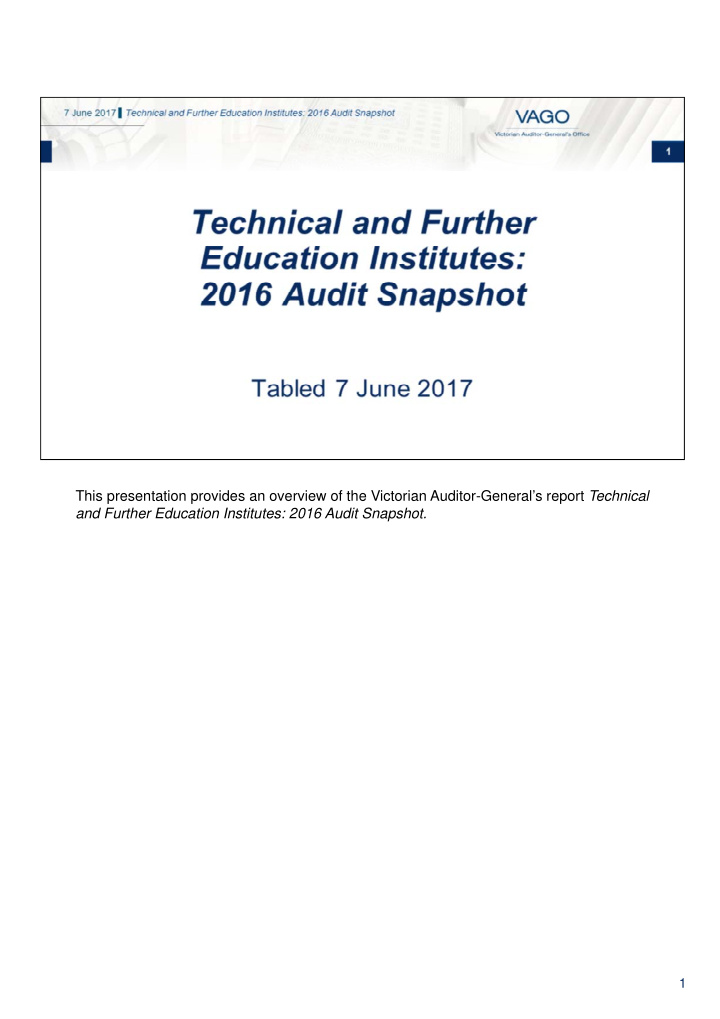



This presentation provides an overview of the Victorian Auditor-General’s report Technical and Further Education Institutes: 2016 Audit Snapshot. 1
This report presents the outcomes of the audits of the 12 technical and further education institutes (TAFEs) for 31 December 2016. In this report we look at matters arising from our audits of both the financial and performance reports, and the financial sustainability of TAFEs. We also provided a focused review of asset maintenance at TAFEs. We concluded that TAFEs’ financial and performance reporting is generally sound, and that financial outcomes for TAFEs are improving. 2
We issued clear opinions on all 11 financial reports and 11 performance reports provided to us for 31 December 2016. We have also finalised the audit of the 2014 and 2015 financial reports of Federation Training. We disclaimed their 2014 financial report. This means we gave no assurance that the numbers were materially correct, because we could not obtain enough appropriate evidence to support them. Management at Federation Training have worked to address the issues raised in 2014 and they have resolved a number of issues. However, concerns remain relating to the numbers coming from the student management system. Consequently, we issued a qualified opinion on the 2015 financial report because we have no assurance that the revenue and associated numbers were correct. We are currently working on the 31 December 2016 financial report for Federation Training. It is expected that Federation Training’s 2017 financial report will report back within the time frame prescribed in the Financial Management Act. Each year we go back and look at the actions management have taken to address issues we report to them in our management letters. It was pleasing to note that the TAFEs had addressed and resolved 75 per cent of the issues raised in 2015. 3
A performance reporting framework for the vocational education sector has now been implemented by the Department of Education and Training (DET). It contains 29 indicators to measure performance on training delivery, outcomes, operating effectiveness, sustainability and compliance. TAFEs must report on four mandatory indicators in their performance report, along with their own previously agreed performance indicators. 4
Between 2012 and 2016, there have been significant changes in how the TAFE sector is funded. In 2013, the sector moved to a contestable funding model with limited government grants that focused on supporting structural reform. As a result, revenue for the sector declined significantly to $74.6 million of government grant funding in 2014. At the same time student numbers for the whole sector were dropping. In 2015 government grant funding was increased to help TAFEs address financial and structural challenges, and increased further to $278.6 million in 2016. The sector’s financial results have improved due to these increases in government funding, and the savings achieved by reducing employee benefit costs. 5
At 31 December 2016, the TAFE sector owned a portfolio of assets valued at $1.95 billion. Seventy per cent of these assets require ongoing maintenance. Each TAFE needs to continuously monitor the state of its assets, and ensure that maintenance works keep them in an acceptable pre-determined condition. To do this effectively, each TAFE should have an asset maintenance framework. We found that the frameworks in place at TAFEs were generally sound, although there are opportunities for improvement. 6
We have previously reported that asset maintenance and renewal is an emerging risk for the sector. Our financial sustainability results confirm this risk remains in 2016. To measure this, we use the capital replacement indicator, which compares spending on asset renewal and replacement in a year to the level of assets consumed, as measured by depreciation. The results for this indicator declined between 2012 and 2015. However, there was an improvement across the sector in 2016 because the sector received $71 million in capital grants from government. Our report also looks at the level of spending on asset maintenance. The results show that maintenance spending has not been at a level sufficient for the sector to sustain its asset portfolio. The year-on-year underspend on asset maintenance, over time, creates a backlog of maintenance, which increases the amount that needs to be spent to bring an asset up to an acceptable standard. This may mean that assets become unusable for the purpose intended. 7
We made three recommendations for DET. We recommended that: • TAFEs without asset maintenance strategies develop them • TAFE asset management strategies be expanded to include short, medium and long- term plans • TAFEs work with DET to identify a suitable software solution to facilitate effective capture and recording of asset information to support strategic asset planning. DET has accepted all recommendations. 8
For further information, please see the full report of this audit on our website, www.audit.vic.gov.au. 9
Recommend
More recommend